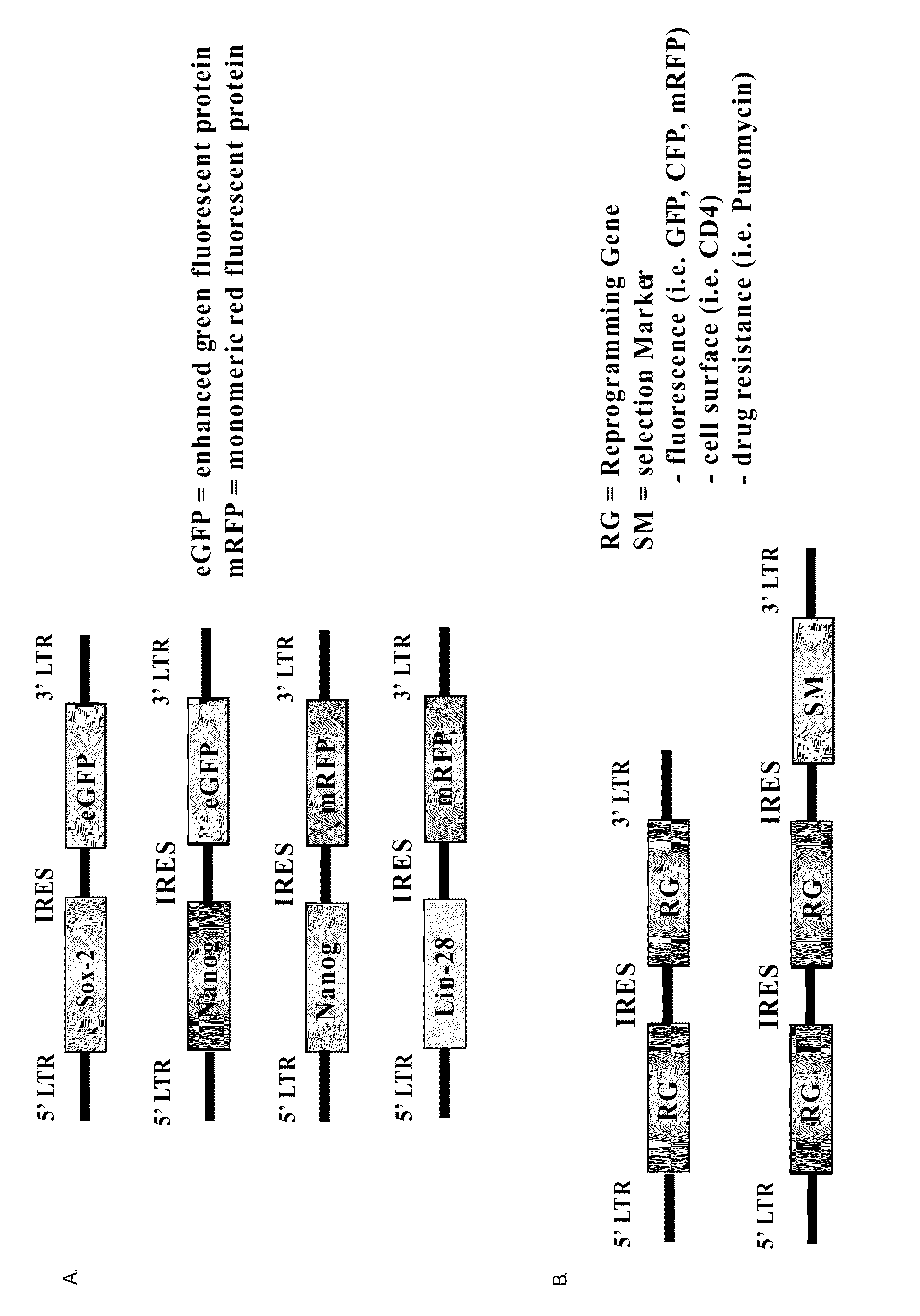Methods for the production of iPS cells
a technology of ips cells and stem cells, applied in the field of stem cells, can solve the problems of slow and inefficient current process for generating induce pluripotent stem cells, no approved treatment or human trial of embryonic stem cells, and reduce efficiency, so as to improve the selection efficiency of transfection and ips cells, reduce proviral copies and the chance of insertional mutagenesis
- Summary
- Abstract
- Description
- Claims
- Application Information
AI Technical Summary
Benefits of technology
Problems solved by technology
Method used
Image
Examples
example 1
Construction of Retroviral Vectors
[0194]The parental retroviral vector for which the reprogramming genes and selection markers were introduced has previously been cited in Kennedy et al. (2003). Briefly, the minimal vector contains the 5′ and 3′ MMLV long terminal repeat region (LTR) in which the 5′ LTR contains the promoter used to drive the expression of the genes required for reprogramming and selection (FIG. 1). Conveniently, there is also a cytomegalovirus promoter located just upstream of the 5′ LTR so that the retroviral plasmids can be used for transient transfection yet will remain nonfunctional when the plasmid is used as a template for viral synthesis.
[0195]As indicated in FIG. 1, Sox-2, Nanog, Oct4, and Lin28 were each introduced into an MMLV-based retroviral backbone also encoding a fluorescent protein. Both Sox-2 and Oct4 were placed into retroviral backbones encoding expression for enhanced green fluorescent protein (eGFP) while Nanog and Lin28 were placed into backbo...
example 2
Generation of Virus Using the Retroviral Vectors
[0196]The retroviral vectors were used in the following way to generate virus. First, each of the four retroviral vectors encoding Sox-2, Oct4, Nanog, or Lin-28 were prepared as separate transfections. Ten micrograms of each retroviral vector were mixed separately with DNA encoding Vesicular Stomatitis Virus-pseudotyped glycoprotein (1 μg), Gag polymerase (3 ug), and NFkB (1 ug). The DNA was then mixed with 500 ul of OptiMem. Separately, 40 microliters of polyethylenimine (1 mg / ml) were mixed with 500 μl OptiMem. The DNA / OptiMem mixture and PEI / OptiMem mixture were then left to incubate at room temperature for 5 minutes then combined to yield approximately 1 ml of solution that must be incubated for at least 20 minutes at room temperature.
[0197]The inventors transfect 293 cells overexpressing the SV40 T-antigen protein that were split one day prior to transfection at a dilution that allows cells to be approximately 80 percent confluent...
example 3
Infection and Plating of Cells
[0198]The procedure involving infection and transition to an environment that allows for reprogramming to take place occurred following one of two methods. One method involved infection and plating of infected and uninfected cells onto irradiated MEFs for reprogramming, and the other method involved plating only infected cells by way of sorting onto MEFs in an effort to enhance the efficiency of reprogramming.
[0199]Method 1: Reprogramming Unsorted IMR-90 Cells Infected with Virus Expressing Reprogramming Genes
[0200]IMR-90 cells have been used successfully as the recipient host for infection, but this protocol is adaptable to the infection of alternative cell types such as primary skin cells and hematopoietic cells. Approximately 50,000 IMR-90 cells were seeded into each well of a 6-well plate 72 hours prior to infection. An additional plate of cells was prepared for use in determining the efficiency of infection for each of the viruses. For example, one...
PUM
| Property | Measurement | Unit |
|---|---|---|
| time | aaaaa | aaaaa |
| time | aaaaa | aaaaa |
| time | aaaaa | aaaaa |
Abstract
Description
Claims
Application Information
 Login to View More
Login to View More - R&D
- Intellectual Property
- Life Sciences
- Materials
- Tech Scout
- Unparalleled Data Quality
- Higher Quality Content
- 60% Fewer Hallucinations
Browse by: Latest US Patents, China's latest patents, Technical Efficacy Thesaurus, Application Domain, Technology Topic, Popular Technical Reports.
© 2025 PatSnap. All rights reserved.Legal|Privacy policy|Modern Slavery Act Transparency Statement|Sitemap|About US| Contact US: help@patsnap.com

